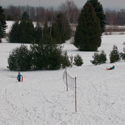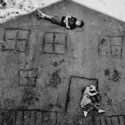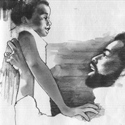 When I see it, the sun has nearly set. The memory card inside my camera is almost full. I don't have a tripod with me. But on the ground-floor the windows are wide open, the doors ripped from their hinges.
When I see it, the sun has nearly set. The memory card inside my camera is almost full. I don't have a tripod with me. But on the ground-floor the windows are wide open, the doors ripped from their hinges.
Jane Cooper Elementary sits gutted in one of the worst parts of one of the most impoverished and dangerous cities in the richest nation in the world. In the late 1990s, Mayor Dennis Archer's office identified this neighborhood as having "more children, more people living in poverty, a greater proportion of high school dropouts, and a larger percentage of violent juvenile offenses than the city as a whole." Which, in Detroit, is saying quite a bit. For several blocks in each direction there are no traces of the neighborhood that once existed here. Most of the houses surrounding the school were torn down for an industrial park that was never built. The school sits alone, a stone monolith on the prairie, still covered in sculptural details and Pewabic tiles.
For several blocks in each direction there are no traces of the neighborhood that once existed here. Most of the houses surrounding the school were torn down for an industrial park that was never built. The school sits alone, a stone monolith on the prairie, still covered in sculptural details and Pewabic tiles. Nearly all of the surrounding streets are blocked off from traffic by Jersey walls; other nearby streets are full of trash that has been illegally dumped there or dragged from the school by scrappers. There are piles of old audio-visual equipment stripped of its metal and wires. There are small scars of soot and ash on the concrete where scrappers have built fires to burn away the plastic coating of electrical wiring. An abandoned boat straddles the edge of the street and the school's parking lot.
Nearly all of the surrounding streets are blocked off from traffic by Jersey walls; other nearby streets are full of trash that has been illegally dumped there or dragged from the school by scrappers. There are piles of old audio-visual equipment stripped of its metal and wires. There are small scars of soot and ash on the concrete where scrappers have built fires to burn away the plastic coating of electrical wiring. An abandoned boat straddles the edge of the street and the school's parking lot. I walk over to a playground built a decade ago with hundreds of thousands of dollars in grant money from private and public sources.
I walk over to a playground built a decade ago with hundreds of thousands of dollars in grant money from private and public sources. Everything is yellow-orange from the setting sun. I listen for the telltale sound of scrappers working inside of the building: sledgehammers, metal-cutting-saws, yelling. The last few times I drove past they were inside, but now there is no one in the building. The scrappers must have headed off for their miles-long shopping-cart journeys to the nearest after-hours scrapyard (where they will get a fraction of the market value for the metal they've stolen). I can't help myself. I have to go in.
Everything is yellow-orange from the setting sun. I listen for the telltale sound of scrappers working inside of the building: sledgehammers, metal-cutting-saws, yelling. The last few times I drove past they were inside, but now there is no one in the building. The scrappers must have headed off for their miles-long shopping-cart journeys to the nearest after-hours scrapyard (where they will get a fraction of the market value for the metal they've stolen). I can't help myself. I have to go in.





 Later, when I'm safe at home, I try to research the school using the limited resources of the internet, and I find little of substance. It was a civil defense fallout shelter before the school itself and the neighborhood around it looked like they were hit by an actual nuclear blast. Newspaper articles mentioning the school provide only stories of trauma experienced by a few students: three young girls lost their lives in a fire at their home in the neighborhood, a 13-year-old wielding a knife had to be escorted out of the school by police, and an 11-year-old girl was raped in her home by two men she met through a "party line" telephone number passed around at the school. There is an article about the dentist who set up shop in the school, providing free dental care to students who had never been to a dentist, and the optometrist who provided eye exams and free glasses to students who could not see the blackboard. And there are countless mentions of the school in the obituaries of old white people, alumni whose lives ended in the suburbs.
Later, when I'm safe at home, I try to research the school using the limited resources of the internet, and I find little of substance. It was a civil defense fallout shelter before the school itself and the neighborhood around it looked like they were hit by an actual nuclear blast. Newspaper articles mentioning the school provide only stories of trauma experienced by a few students: three young girls lost their lives in a fire at their home in the neighborhood, a 13-year-old wielding a knife had to be escorted out of the school by police, and an 11-year-old girl was raped in her home by two men she met through a "party line" telephone number passed around at the school. There is an article about the dentist who set up shop in the school, providing free dental care to students who had never been to a dentist, and the optometrist who provided eye exams and free glasses to students who could not see the blackboard. And there are countless mentions of the school in the obituaries of old white people, alumni whose lives ended in the suburbs.
A cursory bit of research at the archives of the public library and I learn that at one time, "pride of home ownership was evident along tree-lined streets of the neighborhood with two-family flats, large brick bungalows, colonials and '50s-style brick ranches." It was a Slovakian enclave then, but this I already knew from the boarded-up "Slovak Hall" along Strong street. The community was served by St. Cyril's church that stood on this prairie as an epic ruin itself for years before it was demolished in 2003. Jane Cooper Elementary was once considered a good school. But so many questions remain. When was it built? Who was Jane Cooper? How many kids passed through its halls from the 1920s until the building was abandoned? The only other mentions of the school in the recent press are the accounts of its closing in 2007.
You read that correctly: the last year of classes at Jane Cooper Elementary was 2006-7. After that, the cash-strapped Detroit Public Schools shut the school down. All the damage in the photographs I took occurred in just a little over one year. I had expected to be overwhelmed by the sense of loss and tragedy for the kids who last walked these halls, the kids whose names remained written on the blackboards, whose graded quizzes and homework and textbooks sat abandoned on the floor. The kids who made this poster:
I had expected to be overwhelmed by the sense of loss and tragedy for the kids who last walked these halls, the kids whose names remained written on the blackboards, whose graded quizzes and homework and textbooks sat abandoned on the floor. The kids who made this poster: But that is an old story, one for the guys bolder and badder than me, the ones who first broke into this place and found the books still stacked neatly in their fine wooden cabinets, the lockers still in the halls, still occupied, perhaps, by forgotten tokens of individual students. By the time I got here, everything is mixed together. Everything is on the floor. Sure, walking around I give some thought thought to the history of the place, to the segregated classes of solidly-middle-class white kids who over time gave way to segregated classes of poor black kids, all within these same halls, in these same classrooms. I thought about the teachers who taught here, the lifers with careers that spanned decades, the idealists who burned out after only a few years.
But that is an old story, one for the guys bolder and badder than me, the ones who first broke into this place and found the books still stacked neatly in their fine wooden cabinets, the lockers still in the halls, still occupied, perhaps, by forgotten tokens of individual students. By the time I got here, everything is mixed together. Everything is on the floor. Sure, walking around I give some thought thought to the history of the place, to the segregated classes of solidly-middle-class white kids who over time gave way to segregated classes of poor black kids, all within these same halls, in these same classrooms. I thought about the teachers who taught here, the lifers with careers that spanned decades, the idealists who burned out after only a few years. I could go on and on with this false nostalgia. The story I discovered here no longer belongs to the kids, but to those men with minds bent only towards metal. They came in and took everything of worth. They left textbooks, workbooks, chalkboards, maps. Long gone are the lockers, the pipes, the chairs and desks, the electrical wiring, the pencil sharpeners, the metal bookshelves, the aluminum window panes. Perhaps the most shocking of all was finding the once-lovely central auditorium stripped of its antique seating, the chair bases and backs littering the floor like dragon scales, the metal that held the seats together long ago melted down to feed the world's ravenous appetite for steel. It was impossible for me to cross this room without the clatter echoing through the halls like footsteps of an invading army, even though I was quite alone.
I could go on and on with this false nostalgia. The story I discovered here no longer belongs to the kids, but to those men with minds bent only towards metal. They came in and took everything of worth. They left textbooks, workbooks, chalkboards, maps. Long gone are the lockers, the pipes, the chairs and desks, the electrical wiring, the pencil sharpeners, the metal bookshelves, the aluminum window panes. Perhaps the most shocking of all was finding the once-lovely central auditorium stripped of its antique seating, the chair bases and backs littering the floor like dragon scales, the metal that held the seats together long ago melted down to feed the world's ravenous appetite for steel. It was impossible for me to cross this room without the clatter echoing through the halls like footsteps of an invading army, even though I was quite alone. There will never be classes here again. This building, like so many of the students who passed through it, has no hope. All will be rubble soon. When I showed these photos to my wife she asked, "Don't you wonder if any of the scrappers live by some sort of code---that some of them wouldn't scrap a school, or take playground equipment out of the ground?"
There will never be classes here again. This building, like so many of the students who passed through it, has no hope. All will be rubble soon. When I showed these photos to my wife she asked, "Don't you wonder if any of the scrappers live by some sort of code---that some of them wouldn't scrap a school, or take playground equipment out of the ground?"
She has never been inside any of these buildings. Anyone who has seen the inside of such a building knows that these are men without honor. The only code they live by is if I don't take this, someone else will. Where I live, men like these are a force of nature, like piranhas in the Amazon; like locusts on the plains; like vultures circling above you as you try to make your way across the sands.
[Related: my follow up visit to the neighborhood, and my photos of the abandoned Detroit Public Schools Book Depository/Roosevelt Warehouse, with posts here and here.]
Copyright © 2005-2016 Sweet Juniper Media, Inc.
All Rights Reserved.
All Rights Reserved.
"Sweet Juniper" is a registered trademark.
No unauthorized reuse.
No unauthorized reuse.
Categories
- Friday Morning Street Urchin Blogging ( 107 )
- Detroit ( 60 )
- SAHD ( 34 )
- photography ( 30 )
- Thursday Morning Wood ( 25 )
- Halloween ( 23 )
- Thrift ( 18 )
- abandoned places ( 18 )
- terrifying nixon-era children's books ( 16 )
- Reminiscin' ( 15 )
- Sweet Juniper Media ( 11 )
- Wendell ( 10 )
- Design ( 9 )
- San Francisco ( 9 )
- nature fights back ( 9 )
- sleep ( 9 )
- if you ain't dutch you ain't much ( 8 )
- sentimental ( 7 )
- Music ( 6 )
- Parody ( 6 )
- birth story ( 6 )
- scrappers ( 6 )
- Sweet Juniper Tunes ( 5 )
- lawyering ( 5 )
- Zoo ( 4 )
- elegant leisure ( 4 )
- language ( 3 )
- feral houses ( 2 )
- theme parks of the damned ( 2 )
- zombies ( 1 )
Archives
- November 2017 ( 2 )
- December 2016 ( 1 )
- November 2016 ( 2 )
- December 2015 ( 1 )
- November 2015 ( 2 )
- December 2014 ( 1 )
- October 2014 ( 2 )
- April 2014 ( 1 )
- December 2013 ( 2 )
- November 2013 ( 1 )
- October 2013 ( 1 )
- September 2013 ( 2 )
- July 2013 ( 2 )
- June 2013 ( 1 )
- April 2013 ( 1 )
- March 2013 ( 3 )
- February 2013 ( 1 )
- January 2013 ( 1 )
- December 2012 ( 2 )
- November 2012 ( 1 )
- October 2012 ( 4 )
- September 2012 ( 2 )
- August 2012 ( 2 )
- July 2012 ( 1 )
- June 2012 ( 3 )
- May 2012 ( 1 )
- April 2012 ( 2 )
- March 2012 ( 1 )
- February 2012 ( 2 )
- January 2012 ( 1 )
- December 2011 ( 3 )
- November 2011 ( 3 )
- October 2011 ( 5 )
- September 2011 ( 3 )
- August 2011 ( 4 )
- July 2011 ( 4 )
- June 2011 ( 2 )
- May 2011 ( 4 )
- April 2011 ( 6 )
- March 2011 ( 7 )
- February 2011 ( 4 )
- January 2011 ( 4 )
- December 2010 ( 5 )
- November 2010 ( 7 )
- October 2010 ( 5 )
- September 2010 ( 4 )
- August 2010 ( 5 )
- July 2010 ( 7 )
- June 2010 ( 5 )
- May 2010 ( 5 )
- April 2010 ( 5 )
- March 2010 ( 4 )
- February 2010 ( 5 )
- January 2010 ( 5 )
- December 2009 ( 6 )
- November 2009 ( 5 )
- October 2009 ( 8 )
- September 2009 ( 9 )
- August 2009 ( 6 )
- July 2009 ( 9 )
- June 2009 ( 8 )
- May 2009 ( 8 )
- April 2009 ( 8 )
- March 2009 ( 12 )
- February 2009 ( 11 )
- January 2009 ( 9 )
- December 2008 ( 11 )
- November 2008 ( 9 )
- October 2008 ( 14 )
- September 2008 ( 11 )
- August 2008 ( 11 )
- July 2008 ( 12 )
- June 2008 ( 10 )
- May 2008 ( 9 )
- April 2008 ( 8 )
- March 2008 ( 10 )
- February 2008 ( 15 )
- January 2008 ( 12 )
- December 2007 ( 9 )
- November 2007 ( 12 )
- October 2007 ( 11 )
- September 2007 ( 13 )
- August 2007 ( 11 )
- July 2007 ( 8 )
- June 2007 ( 12 )
- May 2007 ( 10 )
- April 2007 ( 10 )
- March 2007 ( 12 )
- February 2007 ( 14 )
- January 2007 ( 12 )
- December 2006 ( 11 )
- November 2006 ( 10 )
- October 2006 ( 13 )
- September 2006 ( 8 )
- August 2006 ( 13 )
- July 2006 ( 13 )
- June 2006 ( 15 )
- May 2006 ( 13 )
- April 2006 ( 9 )
- March 2006 ( 10 )
- February 2006 ( 3 )
- January 2006 ( 5 )
- December 2005 ( 2 )
- November 2005 ( 8 )
- October 2005 ( 4 )
- September 2005 ( 1 )
- July 2005 ( 3 )


























